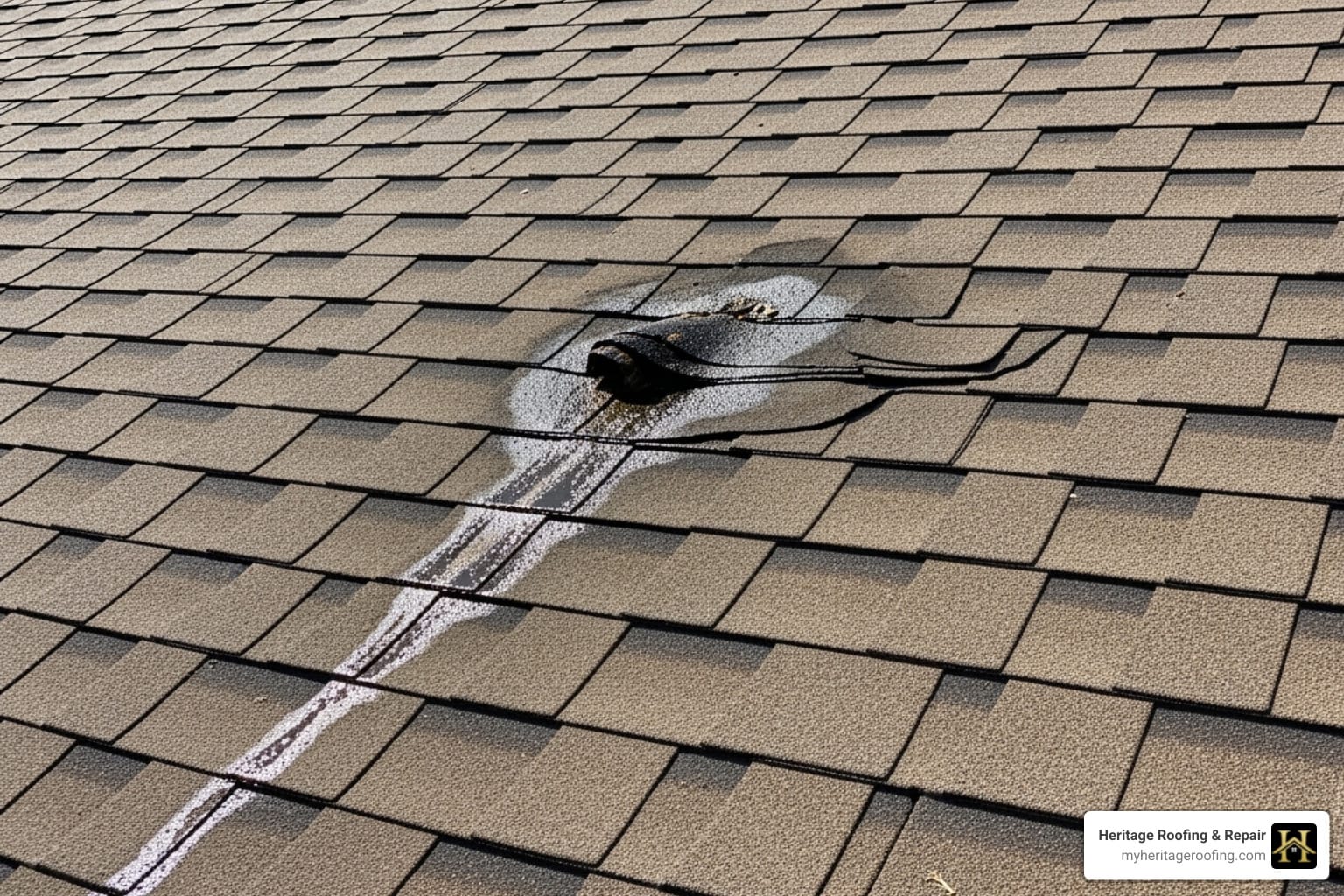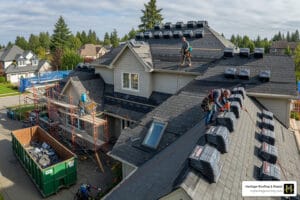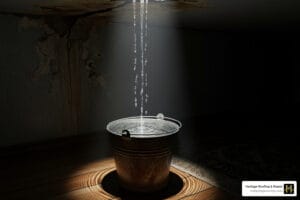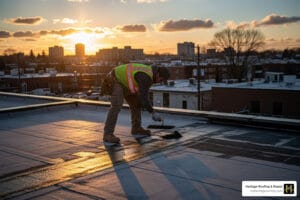Why Immediate Action Is Critical for Roof Water Damage
Residential roof leaks are more than an inconvenience; they are a direct threat to your home’s structural integrity and your family’s health. That first drip signals a critical window to act before minor issues escalate into thousands of dollars in damage. Addressing the problem quickly is essential, and that includes calling for a professional roof repair assessment within 24 hours to understand the scope of the problem. Even small leaks can lead to widespread mold growth and structural rot if ignored.
Common signs of a leak include water stains on ceilings, musty odors, peeling paint, and visible drips. The most frequent culprits are often simple issues like pipe boot failure, backed-out nails, damaged flashing, or clogged gutters.
I’m Rex Wisdom, owner of Heritage Roofing & Repair. Our family has been resolving residential roof leaks and storm damage throughout Northwest Arkansas for over 50 years. This guide will walk you through the exact steps to take when water damage strikes, helping you minimize the impact and protect your most valuable investment.
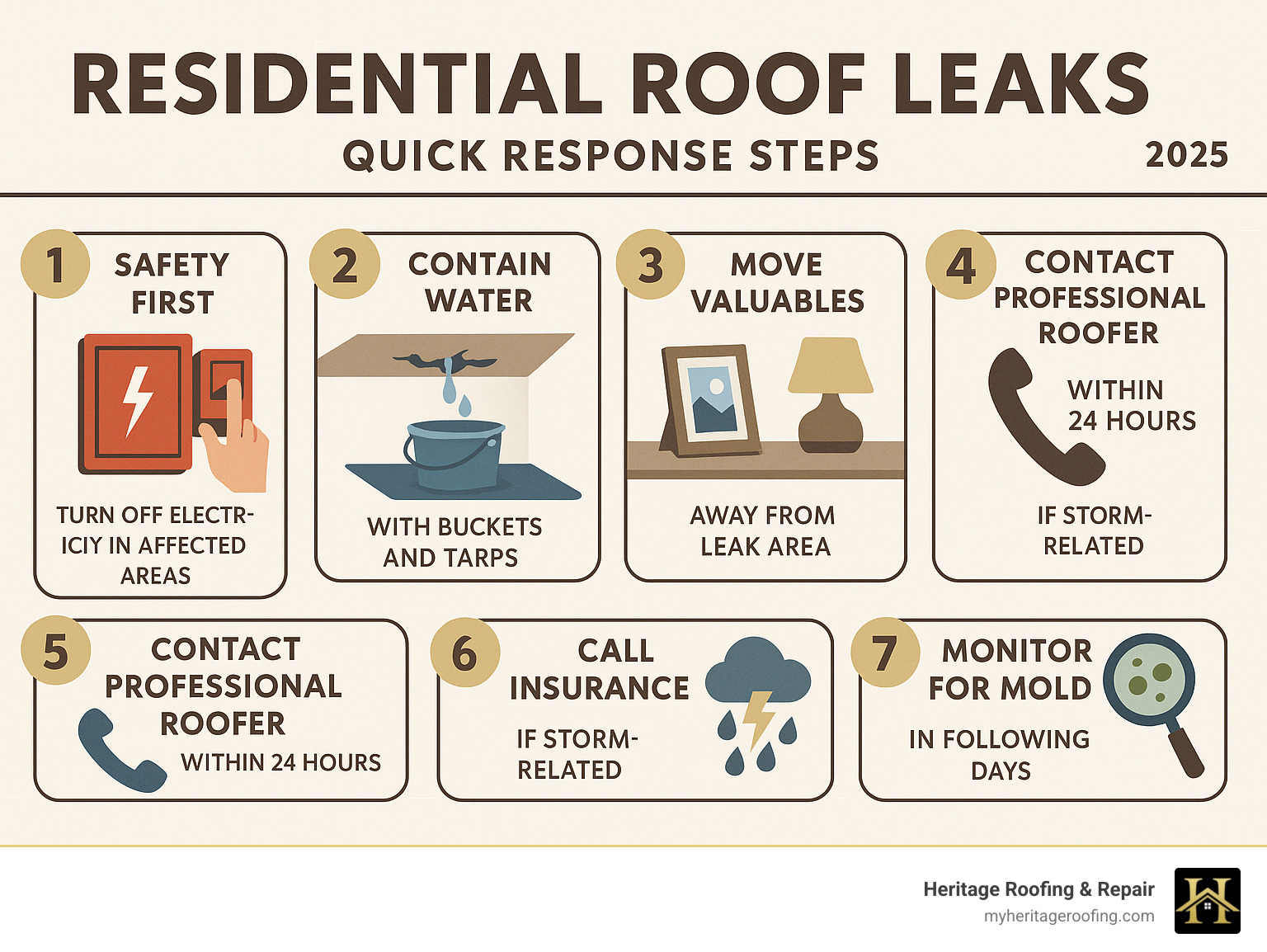
First Response: What to Do the Moment You Spot a Leak
Panic is a natural reaction, but a calm response can save you thousands in secondary damages. Before you worry about the roof, your priority is to control the situation inside your home. These immediate actions will mitigate the damage while you plan your next move.
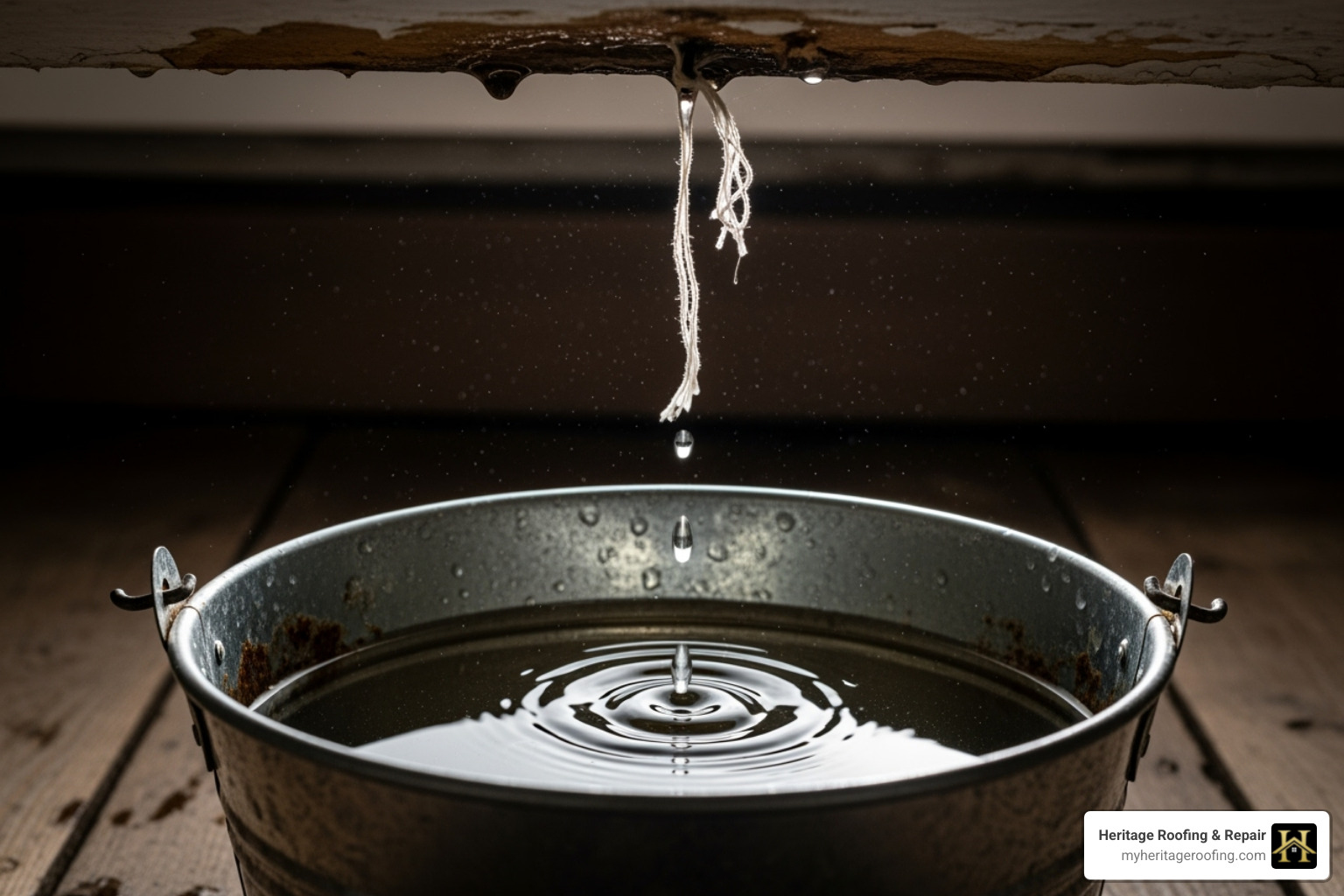
Immediate Damage Control Checklist
- Contain the Drip: Place a bucket or waterproof container directly under the leak to stop water from spreading. To silence the annoying dripping sound, pin a long string to the ceiling near the leak, letting it hang into the bucket. The water will run quietly down the string. Remember to empty the bucket regularly.
- Protect Your Property: Move furniture, electronics, and personal items away from the affected area. Cover larger items that can’t be moved with thick plastic sheeting to shield them from water.
- Manage Ceiling Bulges: A bulge in your ceiling indicates a significant accumulation of water. To prevent a messy collapse, place a large bucket underneath and carefully poke a small hole in the center of the bulge with a screwdriver. This allows the water to drain in a controlled manner, relieving the pressure.
- Prioritize Electrical Safety: Water and electricity are a dangerous mix. If the leak is near light fixtures or outlets, go to your main breaker box and shut off power to the affected area immediately. This crucial step can prevent electrical shocks or a fire.
Taking these steps reduces the extent of water damage and keeps your family safe. While these are temporary measures, they buy you valuable time to arrange for a professional assessment and permanent solution.
Uncovering the Culprit: Common Causes of Residential Roof Leaks
Once the immediate crisis is managed, understanding the cause is the next step. Water can travel far from its entry point, but most residential roof leaks stem from a few common culprits. Identifying the likely source is key to an effective repair.
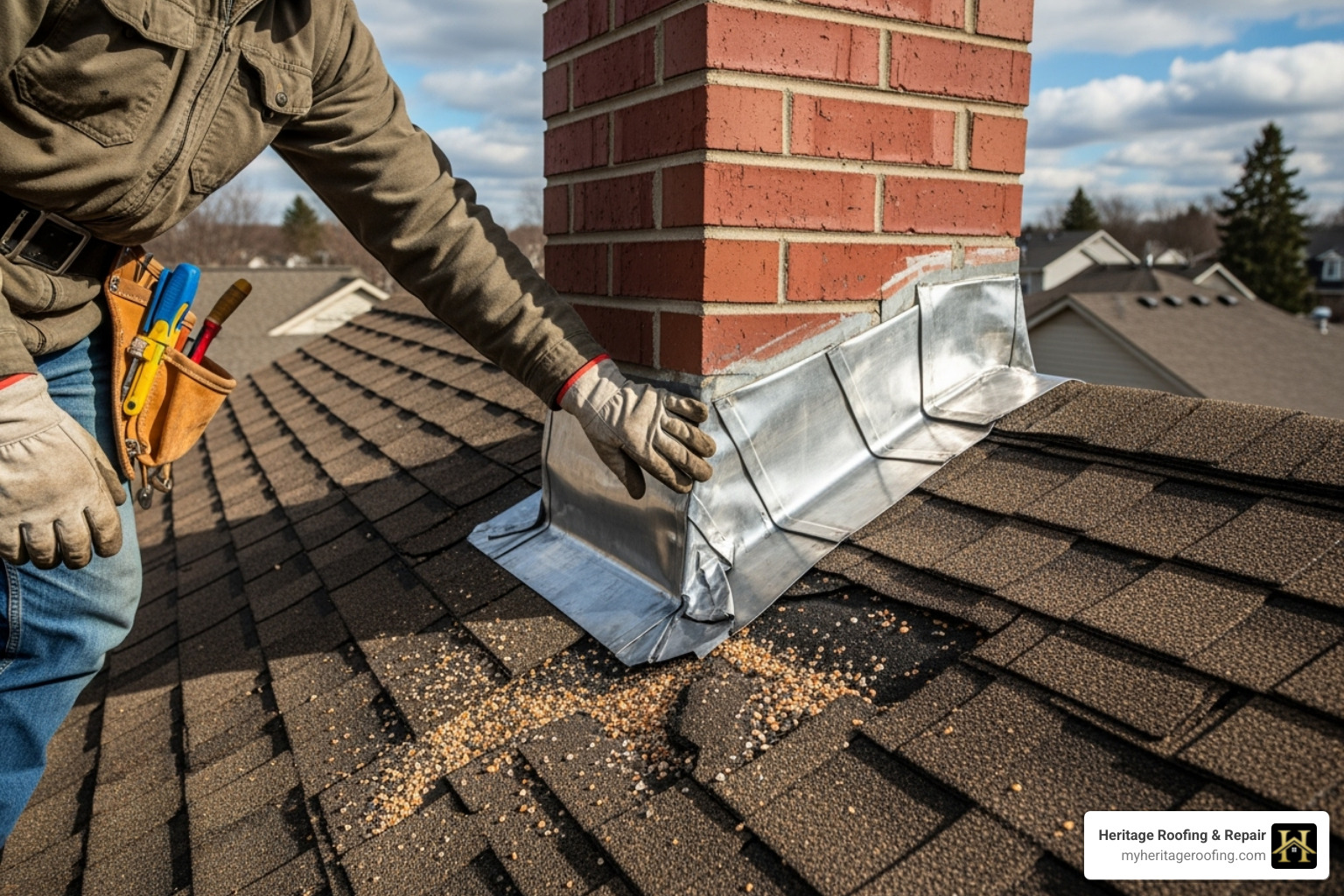
Most leaks come from predictable problem areas. Here are the most common sources we see:
1. Damaged or Missing Shingles
Shingles are your roof’s primary armor. High winds, hail, or falling limbs can crack, lift, or tear them away, exposing the underlayment. Over time, sun exposure makes shingles brittle and prone to failure. A single compromised shingle provides a direct path for water into your home.
2. Failing Flashing and Pipe Boots
Flashing is the metal stripping that seals joints around chimneys, vents, and skylights. If it rusts, cracks, or was installed incorrectly, it creates a highway for water. Pipe boots—the rubber seals around vent pipes—are a top cause of leaks. Constant exposure to UV rays and temperature changes causes them to crack and fail, often within 10 years. Another common issue is nails that have backed out over time, creating small but persistent entry points for water.
3. Ice Dams and Clogged Gutters
In winter, ice dams can form when heat from your attic melts snow, which then refreezes at the colder eaves. This blocks proper drainage, causing water to back up under shingles. Clogged gutters create a similar problem year-round. When packed with debris, they overflow, saturating the roof edge and allowing water to seep underneath.
Pinpointing the exact source can be difficult, as water often travels along rafters before dripping into your living space. This is why a professional inspection is crucial for an accurate diagnosis.
The Hidden Dangers: Why You Can’t Ignore a Leaky Roof
A small, slow leak might not seem like an emergency, but the cumulative damage it causes can be catastrophic. Ignoring a residential roof leak impacts your home’s structural integrity, your family’s health, and your finances.
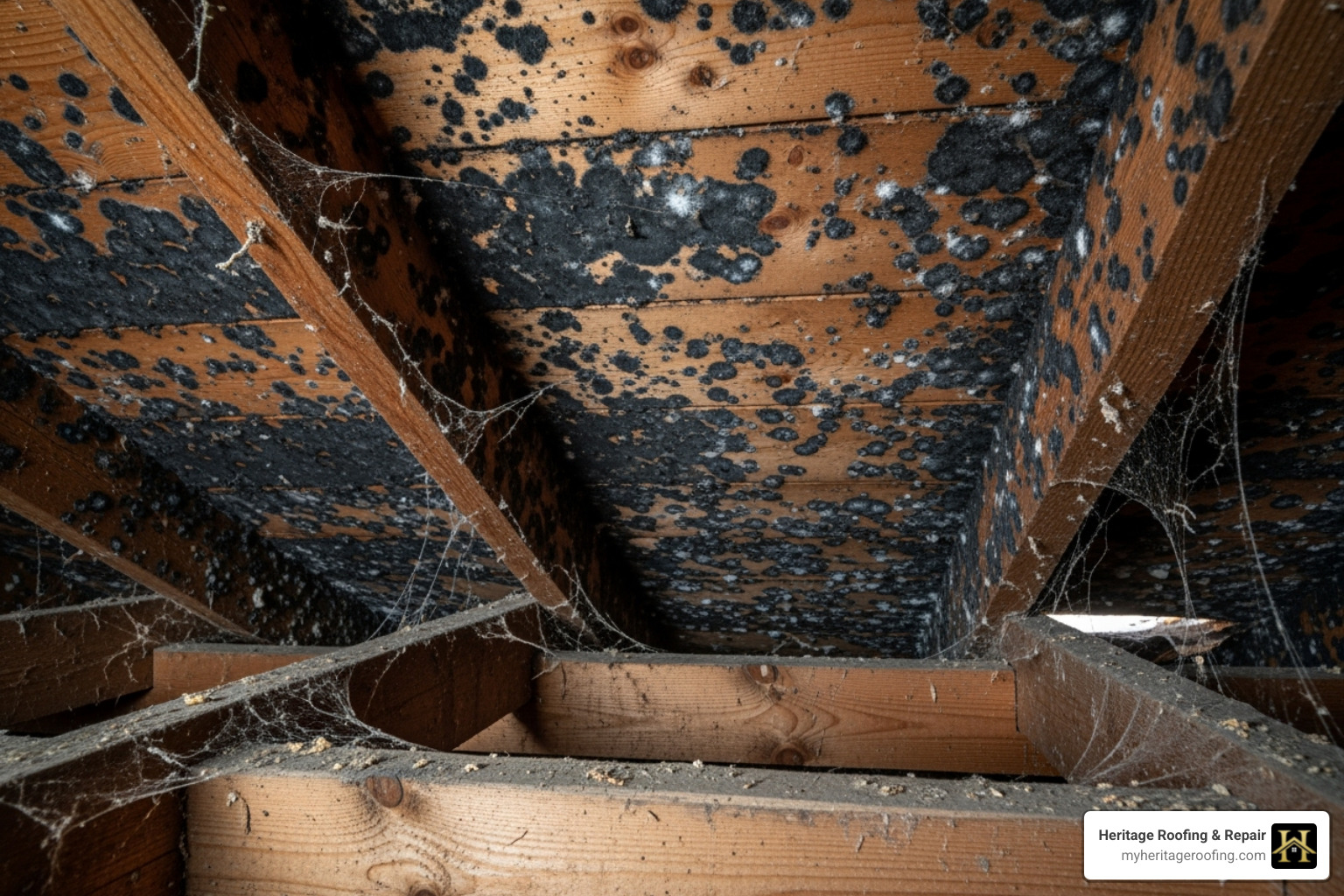
That innocent-looking water stain is a warning sign of serious problems brewing. What starts as a few drops can quickly spiral into thousands of dollars in repairs.
Structural Damage and Rot
Water is relentless. It soaks into roof decking, seeps through insulation, and weakens the wooden framework of your home. Rafters, ceiling joists, and support beams can begin to rot from the inside out, turning solid lumber into a spongy, unreliable mess. In extreme cases, this structural decay can lead to sagging ceilings or even a roof collapse.
Health Hazards from Mold and Mildew
Moisture creates the perfect environment for mold, which can begin to grow within 24 to 48 hours of water exposure. Mold spores released into the air can trigger allergies, asthma attacks, and other serious respiratory issues, according to health authorities like the NY State Department of Health. Since mold often grows in hidden areas like attics and behind walls, it can become a significant health hazard before it’s even visible.
Increased Utility Bills and Property Damage
Water-soaked insulation loses its ability to keep your home comfortable, forcing your HVAC system to work harder and driving up energy bills. Leaks also cause direct damage to your property, ruining ceilings, walls, furniture, and electronics. Furthermore, water reaching electrical wiring creates a serious fire risk from short circuits.
Escalating Costs
The financial consequences of waiting are severe. A minor repair that might cost a few hundred dollars can escalate into a multi-thousand-dollar project involving structural repairs, mold remediation, and extensive interior work. The longer you wait, the more expensive the fix becomes. Prompt action is the only way to protect your home, health, and wallet.
Finding the Source and Planning the Fix: DIY vs. Professional Repair
Deciding how to handle a repair is a critical decision. While some homeowners are handy, roof work is inherently dangerous and complex, and a temporary patch is very different from a lasting repair.
| Feature | DIY Temporary Fix | Professional Repair |
|---|---|---|
| Safety | High risk (falls, electrical hazards, improper ladder use) | Low risk (trained professionals, insured, proper safety gear) |
| Cost (Initial) | Low (materials like tarps, caulk, roofing cement) | Higher (labor, specialized materials, expertise) |
| Effectiveness | Short-term, temporary solution; may trap moisture | Long-term, permanent fix; addresses root cause |
| Warranty | None; may void existing roof warranties | Often comes with labor and material warranties |
| Diagnosis | Limited to obvious signs; may miss hidden issues | Comprehensive, can find hidden sources using advanced techniques |
| Structural Integrity | May not address underlying issues or damage | Addresses and repairs structural damage and rot |
| Insurance Claims | May complicate future claims or lead to denial | Facilitates and supports claims process; provides documentation |
Finding a Hidden Leak
Water can travel along rafters and decking, so the drip you see in your living room may be far from the actual entry point. If the source isn’t obvious, you can check your attic with a flashlight for dark stains, mold, or dampness on the underside of the roof deck. The entry point is often “uphill” from the interior water damage. Always prioritize safety in the attic: wear a mask and gloves, and only step on stable framing.
When to Call a Professional Roofer
A DIY fix with caulk or tar is temporary at best and can trap moisture, accelerating rot and mold growth. A professional roofer has the safety equipment, experience, and diagnostic tools to find the root cause of residential roof leaks. They can identify subtle issues, ensure correct materials are used, and provide a watertight seal that lasts.
A professional roof repair provides warranties, proper documentation for insurance, and peace of mind. Considering the risks and potential for costlier damage from a failed DIY fix, calling a professional is often the most economical choice.
For expert help in the Berryville area, you can rely on our local, experienced team.
Heritage Roofing & Repair
Address: 3458 Arkansas State Hwy 221, Berryville, AR 72616
Phone: (870) 654-1164
Frequently Asked Questions about Residential Roof Leaks
Dealing with a roof leak brings up many questions about cost, insurance, and prevention. Here are concise answers to the most common concerns about residential roof leaks.
How much does it cost to fix a roof leak?
The cost varies widely. Minor repairs (e.g., a few shingles, sealing flashing) can be $150-$500. Moderate repairs involving some decking or more extensive flashing work might range from $500-$1,500. Major repairs with structural damage can exceed $3,000. Key factors influencing the final price are your roofing material, roof accessibility, and the extent of any secondary damage. For a more detailed breakdown, see our guide on roof repair cost.
Will my homeowner’s insurance cover a roof leak?
Coverage depends entirely on the cause. Insurance typically covers leaks from sudden, accidental events like storms, hail, or fallen trees. It generally does not cover leaks caused by old age, lack of maintenance, or gradual wear and tear. Always document the damage with photos, contact your agent promptly, and keep receipts for any temporary repairs you make to prevent further damage.
How can I prevent future roof leaks?
Proactive maintenance is the best way to prevent leaks. Follow these key steps:
- Get Annual Inspections: Have a professional inspect your roof once a year and after major storms to catch issues early.
- Clean Your Gutters: Clean gutters at least twice a year to prevent water backup that can seep under shingles.
- Trim Trees: Keep tree branches trimmed at least three feet away from your roof to prevent scraping damage and debris buildup.
- Address Small Issues: Fix minor problems like a loose shingle or a small gap in sealant immediately before they escalate.
- Check Ventilation: Ensure your attic has proper ventilation to prevent ice dams in winter and reduce heat buildup in summer.
Your Next Step to a Secure, Leak-Free Home
A roof leak is your home’s cry for help. Now that you can recognize the signs, understand the urgency, and know the first steps to take, you are equipped to respond with confidence. While finding a leak is stressful, residential roof leaks are manageable problems when you take swift, informed action.
A professional assessment is non-negotiable for a lasting solution. The small investment in an expert diagnosis now prevents the massive expenses of structural damage and mold remediation later. At Heritage Roofing & Repair, we don’t just patch problems; we solve them with quality craftsmanship and dependable service.
Time is not on your side. Every day you wait, the damage spreads and the cost to fix it grows. Don’t let a manageable repair turn into a major reconstruction. If you’re facing a leak, take action today. Contact our expert roofers in the Fayetteville area for a free, no-obligation inspection. Your home has protected you—now let us help you protect it.
